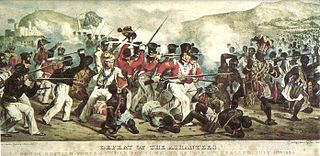Related Research Articles

Kpengla was a King of the Kingdom of Dahomey, in present-day Benin, from 1774 until 1789. Kpengla followed his father Tegbessou to the throne and much of his administration was defined by the increasing Atlantic slave trade and regional rivalry over the profits from this trade. His attempts to control the slave trade generally failed, and when he died of smallpox in 1789, his son Agonglo came to the throne and ended many of his policies.
Osei Bonsu also known as Osei Tutu Kwame was the Asantehene. He reigned either from 1800 to 1824 or from 1804 to 1824. During his reign as the king, the Ashanti fought the Fante confederation and ended up dominating Gold Coast trade. In Akan, Bonsu means whale, and is symbolic of his achievement of extending the Ashanti Empire to the coast. He died in Kumasi, and was succeeded by Osei Yaw Akoto.

Atakpamé is the fifth largest city in Togo by population, located in the Plateaux Region of Togo. It is an industrial centre and lies on the main north-south highway, 161 km north of the capital Lomé. It is also a regional commercial centre for produce and cloth.
Opoku Ware I was the 2nd Asantehene of Oyoko heritage, who ruled the Ashanti Empire. Between 1718 and 1722, Opoku Ware became Asantehene during a period of civil disorder after the death of the 1st Asanthene. From 1720 to 1721, Opoku established his power.

Denkyira or Denkyera was a powerful nation of Akan people that existed before the 1620s, in what is now modern-day Ghana. Like all Akans, they originated from Adanse Kingdom. Before 1620, Denkyira was called Agona. The ruler of the Denkyira was called Denkyirahene and the capital was Jukwaa. The first Denkyirahene was Mumunumfi.

The Akyem are an Akan people. The term Akyem is used to describe a group of four states: Asante Akyem, Akyem Abuakwa, Akyem Kotoku, and Akyem Bosome. These nations are located primarily in the eastern region in south Ghana. The term is also used to describe the general area where the Akyem ethnic group clusters. The Akyem ethnic group make up between 3-4 percent of Ghana's population depending on how one defines the group and are very prominent in all aspects of Ghanaian life. The Akyem are a matrilineal people. The history of this ethnic group is that of brave warriors who managed to create a thriving often influential and relatively independent state within modern-day Ghana. When one talks of Ghanaian history, there is often mention of The Big Six. These were six individuals who played a big role in the independence of Ghana. Of the big six, people of Akyem descent made up the majority.
Osei Kwadwo was the 4th Asantehene of the Ashanti Empire who reigned from 1764 to 1777. Osei Kwadwo was elected in replacement of Kusi Obodom who was removed out of power.
Akwamu was a state set up by the Akwamu people in present-day Ghana. After migrating from Bono state, the Akan founders of Akwamu settled in Twifo-Heman. The Akwamu led an expansionist empire in the 17th and 18th centuries. At the peak of their empire, Akwamu extended 400 kilometres (250 mi) along the coast from Ouidah, Benin in the East to Winneba, Ghana, in the West.

The Asante Empire, also known as the Ashanti Empire, was an Akan state that lasted from 1701 to 1901, in what is now modern-day Ghana. It expanded from the Ashanti Region to include most of Ghana and also parts of Ivory Coast and Togo. Due to the empire's military prowess, wealth, architecture, sophisticated hierarchy and culture, the Asante Empire has been extensively studied and has more historic records written by European, primarily British, authors than any other indigenous culture of sub-Saharan Africa.
The Battle of Atakpamé (1764) was an armed confrontation between the Ashanti Empire and neighboring Akan Allies under the leadership of the Kingdom of Akyem who joined up with the Kingdom of Dahomey under the Oyo Empire in and around Atakpamé in Togo.

Otumfuo Opoku Ware II was the 15th Asantehene. He succeeded his uncle Osei Tutu Agyeman Prempeh II on 27 July 1970. He ruled for 29 years until his death in February 1999. He was succeeded by Otumfuo Nana Osei Tutu II.

An Akrafena is an Ashanti sword, originally meant for warfare but also forming part of Ashanti heraldry. The foremost example of an akrafena is the Mponponsuo, which belonged to Opoku Ware II. It has survived to the present day because it is still occasionally used in ceremonies, such as the Akwasidae Festival.

The Katamanso War, also known as the Battle of Dodowa, was a war that several tribes united with the British, fought and prevented Ashantis from dominating the coast in 1826. Numerous tribes in the Gold Coast such as the Fantes, Ga, Akyems, Adas were led by the British army to fight the Ashantis. It is classified as one of the "Anglo-Ashanti Wars" according to historical evidence at the National Archives.

The Asante Empire was an Akan empire and kingdom from 1701 to 1957, in modern-day Ghana. The military of the Asante Empire first came into formation around the 17th century AD in response to subjugation by the Denkyira Kingdom. It served as the main armed forces of the empire until it was dissolved when the Asante became a British crown colony in 1901. In 1701, King Osei Kofi Tutu I won Asante independence from Denkyira at the Battle of Feyiase and carried out an expansionist policy.
The political organization of the historical Asante Empire was characterized by stools which denoted "offices" that were associated with a particular authority. The Golden Stool was the most powerful of all, because it was the office of the King of the Asante Empire. Scholars such as Jan Vansina have described the governance of the Asante Empire as a federation where state affairs were regulated by a council of elders headed by the king, who was simply primus inter pares.

Konadu Yaadom, also Kwadu Yaadom was the fourth Asantehemaa of the Ashanti Empire, whose multiple marriages and spiritual influence meant that she became an important and powerful ruler in the eighteenth and early nineteenth centuries.
8 roads with several sub routes were built by the Asante Empire to connect the capital with cities north and south of the empire starting from the 18th century. Asante roads were supervised and policed by the government, but the sacred roads of the state received more attention. 4 main roads were directed northwards of the state whiles the other 4 were built south and towards the Coast. The southern roads of the Asante Empire fell into decline in the late 19th century and the entire road network was abandoned following British colonization.

The Aban was a stone structure that served as a palace for the Asantehene and played the other function of displaying his craft collection. It was constructed in 1822 as a project of Asantehene Osei Bonsu, with the stones and labor provided by the Dutch at Elmina. The palace was destroyed in 1874 during the British invasion and its remains were used to construct a British fort in the late 19th century.
The Asantehemaa is the queen mother according to West African custom, who rules the Asante people alongside the Asantehene. African queen mothers generally play an important role in local government; they exercise both political and social power. Their power and influence have declined considerably since pre-colonial times, but still persist in the 21st century.

Opoku Fofie, born around 1775 and died in March 1804, was the sixth asantehene (monarch) of the Ashanti Empire, belonging to the dynastic house of Opoku Ware of the Oyoko clan. The youngest son of the asantehemaa Konadu Yaadom and Adu Twum Kaakyire, he acceded to the throne by the principle of dynastic alternation in force since the founding of the empire, after the crisis that opposed his mother to her predecessor Osei Kwame from 1797 to 1803.
References
- 1 2 "Ashanti". Oxford Reference. Retrieved 2023-01-23.
- 1 2 McCaskie, T. C. (2003-10-30). State and Society in Pre-colonial Asante. Cambridge University Press. p. 176. ISBN 978-0-521-89432-6.
- 1 2 3 4 5 6 7 8 9 10 Fynn, John K. (1965). "The Reign and Times of Kusi Obodum, 1750-64". Transactions of the Historical Society of Ghana. 8: 24–32. JSTOR 41403567. S2CID 155465956.
- 1 2 Ivor Wilks (1989) , p. 128
- ↑ Eisenstadt, Abitbol & Chazan (1988) , p. 80
- 1 2 Parker, John (2021). In My Time of Dying: A History of Death and the Dead in West Africa. Princeton University Press. p. 149. ISBN 9780691193151.
- ↑ Law, Robin (1985). "Human Sacrifice in Pre-Colonial West Africa". African Affairs. 84 (334): 53–87. doi:10.1093/oxfordjournals.afraf.a097676. JSTOR 722523. S2CID 148957590.
- ↑ Ivor Wilks (1989) , p. 35
- ↑ Ivor Wilks (1989) , p. 21–22
- ↑ Eisenstadt, Abitbol & Chazan (1988) , p. 79
- ↑ Priestley, Margaret (1961). "The Ashanti Question and the British: Eighteenth-Century Origins". The Journal of African History . 2 (1): 35–59. doi:10.1017/S0021853700002139. JSTOR 179582. S2CID 153355150.
- 1 2 3 Ivor Wilks (1989) , p. 26–27
- ↑ Ivor Wilks (1989) , p. 53
- 1 2 3 4 Ivor Wilks (1989) , p. 320
- ↑ Fage, J.D. and Roland Oliver (1975). The Cambridge History of Africa: From c. 1600 to c. 1790, edited by Richard Gray. Cambridge: Cambridge University Press. p. 315. ISBN 0521204135.
- 1 2 Ivor Wilks (1989) , p. 322
- ↑ Ivor Wilks (1989) , p. 129
Bibliography
- Eisenstadt, Shmuel Noah.; Abitbol, Michael; Chazan, Naomi (1988). The Early State in African Perspective: Culture, Power, and Division of Labor. Brill. ISBN 9004083553.
- Ivor Wilks (1989). Asante in the Nineteenth Century: The Structure and Evolution of a Political Order. CUP Archive. ISBN 9780521379946 . Retrieved 2020-12-29– via Books.google.com.